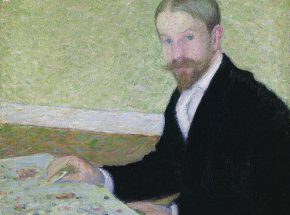

In the development of American Impressionism, Robert Vonnoh is significant both as a painter and as a teacher. He was one of the earliest painters to bring European impressionism to America and his canvases had cool tones and balanced compositions with much capturing of light and atmosphere. He completed more than 500 commissioned portraits, and he had a distinguished teaching career in Boston and Philadelphia.
Vonnoh was born in 1858 in Hartford, Connecticut and raised in Boston. He studied at the Massachusetts Normal Art School in 1875, and attended the Academie Julian in Paris in 1880. There he studied with Gustave Boulanger and Jules Joseph Lefebvre. In 1883, he returned to Boston where he taught at the Cowles School in 1884 and at the School of the Museum of Fine Arts in 1885.
In 1886, he married, and he and his wife honeymooned briefly in Grez, France. The following year they returned to France, this time for a longer stay, and his work began to display a new direction.
Vonnoh studied French Impressionism and was impressed by Claude Monet, whose influence can be seen in his works of colorful landscapes and bright flowers. His painting at this time also demonstrates the dichotomy of many American Impressionists. Some of his works are almost Fauvist, with raw brilliant colors and paint laid on with wide brushes or palette knife, as in his painting “Poppies” in 1888. Other works from about the same time are done almost entirely in neutral tones, as in “Companion of the Studio”, a solid three-dimensional portrait of John C. Pinhey, who was a fellow student at the Julian Academy.
Vonnoh’s gradual change towards Impressionism seems to have been influenced by his friendship with the Irish artist Roderick O’Conor, who also was painting in Grez in the 1880s and used unmixed hues and thick impasto in his bright landscapes. Towards the end of the decade, O’Conor had become associated with Van Gogh, and after 1890 he left Grez to go to Pont-Aven, where he painted with the group around Gauguin.
Vonnoh’s works in Grez explored light and color in a variety of seasons. His paint was often broadly applied and unmixed, and he liked to use pure color and higher key, juxtaposing the violets, lavenders, and purples of Impressionism.
In 1891, he was back in Boston, converted to Impressionism, and later that year he held a one man show at the Williams and Everett Gallery which included many of the paintings he had done in France.
Vonnoh returned to Pennsylvania in 1891 to teach at the Academy of the Fine Arts, where he continued his enthusiasm for French impressionism. He maintained a commitment to academics, but also encouraged an Impressionistic aesthetic.
At the Pennsylvania Academy he taught portraiture, where his instruction was very popular. Among his students there were Robert Henri, William Glackens, and Maxfield Parrish. He divided his time between teaching and painting, especially portraits, although he did landscapes as well.
He married his second wife, the sculptor Bessie Potter, in 1899, and she is shown in a number of garden landscapes he painted. These paintings are rich in color, suggestive of his time spent in Grez, but his later works become more timid.
Vonnoh died in Nice, France in 1933.
Source:
“300 Years of American Art” by Michael David Zellman
